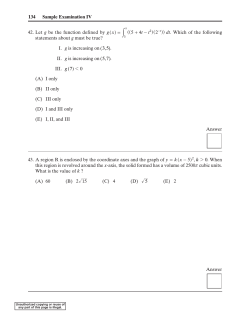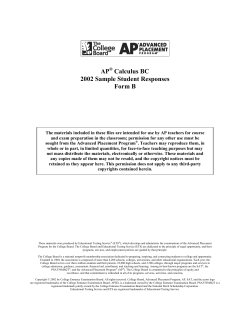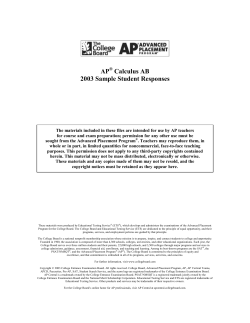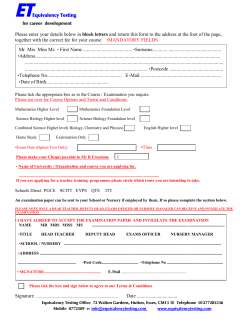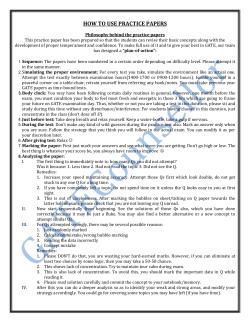
Document 267711
SAMPLE EXAMINATION The purpose of the following sample examination is to present an example of what is provided on exam day by ASQ, complete with the same instructions that are given on exam day. The test questions that appear in this sample examination are retired from the SSGB pool and have appeared in past SSGB examinations. Since they are now available to the public, they will NOT appear in future SSGB examinations. This sample examination WILL NOT be allowed into the exam room. Appendix A contains the answers to the sample test questions. ASQ will not provide scoring and analysis for this sample examination. Remember: These test questions will not appear on future examinations so your performance on this sample examination may not reflect how you perform on the formal examination. A self-appraisal of how well you know the content for the specific areas of the body of knowledge (BOK) can be completed by using the worksheet in Appendix B. On page 2 of the instructions, it states “There are 100 questions on this 4-hour examination.” Please note that this sample exam only contains 25 questions. If you have any questions regarding this sample examination, please email mrehm@asq.org © 2008 ASQ ASQ grants permission for individuals to use this sample examination as a means to prepare for the formal examination. This examination may be printed, reproduced and used for non-commercial, personal or educational purposes only, provided that (i) the examination is not modified, and (ii) ASQ’s copyright notice is included. The user assumes all risks of copyright infringement. THIS PAGE WAS LEFT BLANK INTENTIONALLY NAME____________________________________ CERTIFIED SIX SIGMA GREEN BELT Please print your name above. Read all the instructions before beginning the examination. If you are unsure about any part of the instructions, consult your proctor. General Instructions All answers must be recorded on the Scantron Answer Sheet; no exam will be graded with the answers marked in the exam booklet. 1. Using a soft lead pencil (#2 or softer) only, blacken the circle of the correct answer. Do not use ink. If you change your answer, be sure to erase the previous answer completely. 2. Each question has ONE correct answer only. 3. This is a timed test; do not linger over difficult questions. Instead, skip the questions of which you are unsure; return to them when you reach the end of the test. 4. Do not fold, staple, or tear the answer sheets. 5. Although this is an open book examination and personally generated materials/notes from training or refresher courses are allowed, the following conditions apply: • Each examinee must make his/her reference materials available to the proctor for review. • Absolutely no collections of questions and answers or weekly refresher course quizzes are permitted. Reference sources that contain such copy are not allowed unless the questions and answers are removed or obscured. Examples of such sources include but are not limited to refresher and preparatory primers. • Calculator Policy: With the introduction of palmtop computers and increasing sophistication of scientific calculators, ASQ has become increasingly aware of the need to limit the types of calculators that are permitted for use during the examinations. Any silent, hand-held, battery-operated calculator WITHOUT an alphabetic keyboard will be permitted; however, all programmable memory must be cleared from the calculator before you enter the exam room. The examination is written so that a simple calculator will be sufficient to perform calculations. − • No laptop or palmtop computers are allowed. Reference materials and calculators may not be shared. 6. When you have finished, check your answer sheet to be sure it is properly identified with your name and member number. Return your examination booklet, answer sheet, examinee comment form and scratch paper to your proctor. You must sign the roster sheet to signify the return of your test booklet. 7. It is strictly forbidden to copy or remove examination materials. You will be disqualified from the examination and not certified by ASQ if you breach this trust. 8. TEST RESULTS – you can check your test results 7-9 days after the exam date by logging into the www.asq.org website and navigating to the Certification webpage. Otherwise, your exam results will be mailed in approximately three weeks. Please Be Patient we do not answer telephone requests for results. SSGB Sample Exam Special Instructions 1. Please note that your answer sheet has been personalized with your name, member number, section number, and test type. 2. Do NOT make any changes to these parts of the answer sheet. Doing so will only delay your exam results. Notify the Proctor of any changes. 3. If you don’t have a personalized answer sheet, see your Proctor for further instructions. 4. There are 100 questions on this 4-hour examination. Please check that you have the correct number of questions. STOP DO NOT CONTINUE UNTIL INSTRUCTED SSGB-SAMPLE EXAM CERTIFIED SIX SIGMA GREEN BELT Test Directions: Each of the questions or incomplete statements below is followed by four suggested answers or completions. Select the one that is best in each case and then fill in the corresponding space on the answer sheet. 3. Which of the following measures is increased when process performance is improved? 1. The statistics that summarize a population are referred to as (A) categorical statistics (B) descriptive statistics (C) probabilistic statistics (D) control statistics (A) Variability range (B) Capability index (C) Repeatability index (D) Specification limits 2. The following chart was developed by a six sigma team to measure reactions on two different products. 4. Which of the following tools can be used to identify and quantify the source of a problem? Temperature (˚C) 140 — (A) Affinity diagram (B) Control chart (C) Pareto chart (D) Quality function deployment 120 — 100 — 80 — 60 — 5. A correlation analysis is used to provide a numeric value for which of the following types of relationships between two variables? 40 — 20 — (A) Random (B) Linear (C) Curvilinear (D) Causation 0— Product X Product Y In this chart, temperature represents the (A) repetition (B) factor (C) response (D) level 3 SSGB-SAMPLE EXAM 6. Which of the following tools is used to translate broad requirements into specific requirements? 11. Which of the following is a commonly accepted level for alpha risk? (A) A quality control plan (B) The theory of constraints (TOC) (C) A critical to quality (CTQ) tree (D) A process flowchart (A) 0.05 (B) 0.50 (C) 0.70 (D) 0.95 7. Which of the following tools is used extensively in quality function deployment (QFD)? 12. When the sampling method used creates a difference between the result obtained from the sample and the actual population value, the difference is known as (A) Affinity diagram (B) Matrix diagram (C) Cause and effect diagram (D) Activity network diagram (A) correlation (B) precision (C) accuracy (D) bias 8. Which of the following control charts is used to monitor discrete data? 13. Which of the following is an example of mistakeproofing? (A) p (A) Using an X - R chart to prevent errors (B) Using 100% inspection to detect and contain defects (C) Using color coding as an error signal (D) Having the team that created the errors repair them (B) I & mR (C) X (D) X − R 14. Which of the following is the key objective of a six sigma project? 9. Which of the following shapes is used to present a termination point in a flowchart? (A) Developing detailed control charts for critical processes (B) Developing a matrix to understand the how’s and what’s of a problem process (C) Reducing variation in critical processes (D) Reducing investment costs while improving output quality (A) Rectangle (B) Diamond (C) Arrow (D) Oval 10. For a normal distribution, two standard deviations on each side of the mean would include what percentage of the total population? (A) 95% (B) 68% (C) 47% (D) 34% 4 SSGB-SAMPLE EXAM 19. In order for value flow analysis to be effective, a team must take which of the following steps first? 15. Which of the following tools is used to identify potential events and contingencies for an implementation plan? (A) Define the value stream (B) Eliminate backlogs in the value stream (C) Identify overlapping functions in the value stream (D) Identify specific work practices within the value stream (A) PERT chart (B) Process decision program chart (C) Fishbone diagram (D) House of quality 16. Which of the following measures is used to show the ratio of defects to units? 20. When an inspection process rejects conforming product, what type of error is being made? (A) DPU (B) DPO (C) DPMO (D) PPM (A) α (B) β (C) σ (D) H0 17. Which of the following terms is used to describe the risk of a type I error in a hypothesis test? 21. The critical path for a project is best described as the (A) Power (B) Confidence level (C) Level of significance (D) Beta risk (A) sequence of steps with the highest costs (B) tasks in the project that have the highest risk of failure (C) sum of the tasks with the shortest time requirements (D) longest path from the start to the completion of the project 18. Positional, cyclical, and temporal variations are most commonly analyzed in (A) SPC charts (B) multi-vari charts (C) cause and effect diagrams (D) run charts 5 SSGB-SAMPLE EXAM 23. Statistical process control (SPC) is best defined as the use of 22. Which of the following graphs represents a factorial experiment with the strongest interaction? (A) Pareto charts to understand and control a process (B) inputs to control critical and complex processes (C) statistical methods to identify and remove manufacturing errors (D) statistical methods to understand and control a process Response (A) B 3— B+ 2— 1— + B– B– – A + 24. A measurement system analysis is designed to assess the statistical properties of Response (B) – 3— B (A) gage variation (B) process performance (C) process stability (D) engineering tolerances 2— 1— B– B+ B+ — A + 25. When calculating the Cp index, what does the standard USL − LSL ? deviation represent in the formula C p = 6σ (A) The tolerance interval (B) The confidence interval for the result (C) The range of the process (D) The variance of the index Response (C) 3— B– 2—B + B+ 1 — B– — A + Response (D) 3— 2—B + B+ 1 —– B — B– A + END OF EXAM IF YOU FINISH BEFORE TIME IS CALLED, YOU MAY GO BACK AND CHECK YOUR WORK ON THIS TEST. 6 SSGB-SAMPLE EXAM APPENDIX A: Answer Sheet For each sample test question, the correct answer is provided below along with the area of the body of knowledge (BOK) that the item is classified to. This sample examination is not intended to represent all areas of the BOK but to provide a sampling from each major topic area. All ASQ examinations are based on the BOK for that particular exam. To view the BOK for SSGB, please go to http://www.asq.org/certification/six-sigma-green-belt/bok.html Question 1 2 3 4 5 6 7 8 9 10 11 12 13 14 15 16 17 18 19 20 21 22 23 24 25 BOK III.A.2 V.A.1 II.D.1 III.C.5 IV.A.2 I.A.2 I.C.1 V.B.3 II.D.1 III.D. IV.B.1 III.C.3 V.D. I.A.2 II.C.6 II.D.2 IV.B.1 IV.A.1 I.B.1 IV.B.1 II.B.4 V.A.2 V.B.1 III.E. III.F.3 Correct Answer B C B C B C B A D A A D C C B A C B A A D C D A C 7 SSGB-SAMPLE EXAM APPENDIX B: Analyzing Body of Knowledge (BOK) Content The following worksheet can be used to help you analyze the results of your answers on this sample examination. It can be used to determine which areas of the body of knowledge (BOK) you may want to study. After learning which sample test questions you had correct, total the number you had correct and enter that number into the 2nd column of the worksheet. The 3rd column provides the total number of test questions that are in this sample examination for that major area of the BOK. The last column provides the total number of test questions that appear in a formal ASQ examination for that area of the BOK. BOK Topic Area I. Overview: Six Sigma and the Organization II. Six Sigma – Define Total You Had Correct on Sample Exam III. Six Sigma – Measure IV. Six Sigma – Analyze V. Six Sigma – Improve & Control GRAND TOTAL 8 Total in the Sample Exam Total in Formal ASQ Exam 4 15 5 25 6 30 5 15 5 15 25 100
© Copyright 2025









